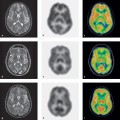Starting Point
O. Schober
W. Heindel
The authors have sought to foreground something that everyone recognizes at least to a degree: the complementary nature of two imaging modalities that are brought together, almost simultaneously, to create a hybrid system. Their fusion has a synergy for users–physicians, patients, researchers, and the scientific community–that can be expressed mathematically as 1+1≥2.
Future prospects are positive, and important developments are anticipated. This is true not just for PET and CT, which are our paradigms for molecular and morphologic information, but also for ultrasonography, SPECT, optical imaging, and MR spectroscopy (MRS) on the one hand, and to the combination of MRI and, again, ultrasonography on the other. Living examples are SPECT-CT or, for the near future, MR-PET. Synergies will be optimized by the use of different tracers and contrast media, and by adding the temporal dimension during data acquisition and object imaging, imaging will advance to the truly 4D (Fig. 6.1).
Teaching
University teaching begins with the facts and principles of anatomy, physiology, and biochemistry. Even at this early stage, it is important to give students a sense of the broader context of the material as a whole. Bringing together anatomy (morphology), physiology (function), and biochemistry (molecular information) at an early stage in medical training will deepen the learning experience and increase the motivation for this career choice. This particularly applies to the imaging of diseases. Therefore, imaging specialities have to be integrated in preclinical teaching.
Continuing Education
The imaging specialties of radiology and nuclear medicine have their origins in both radiography and internal medicine, particularly endocrinology. The representation of the specialties and their competences and responsibilities in health care are regulated by continuing education requirements for specialist certification. This takes a long time—years—in which doctors, for good reason, cannot practice on their own.
Aside from this, multimodal imaging holds a fascination for young doctors, in part because the strengths of various specialties are brought together on an interdisciplinary basis. It is important to develop a common, time-limited training route without sacrificing the autonomy that is appropriate for different specialties.

Fig. 6.1 Capabilities of various imaging modalities
Stay updated, free articles. Join our Telegram channel

Full access? Get Clinical Tree






